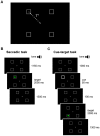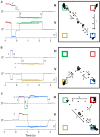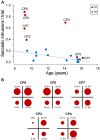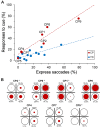Visuospatial Attention and Saccadic Inhibitory Control in Children With Cerebral Palsy
- PMID: 31780913
- PMCID: PMC6856641
- DOI: 10.3389/fnhum.2019.00392
Visuospatial Attention and Saccadic Inhibitory Control in Children With Cerebral Palsy
Abstract
Cerebral palsy (CP) is a non-progressive syndrome due to a pre-, peri- or post-natal brain injury, which frequently involves an impairment of non-motor abilities. The aim of this article was to examine visuospatial attention and inhibitory control of prepotent motor responses in children with CP showing a normal IQ or mild cognitive impairment, measuring their performance in oculomotor tasks. Ten children (9-16-year-old) with spastic CP and 13 age-matched, typically developing children (TDC) participated in the study. Subjects performed a simple visually-guided saccade task and a cue-target task, in which they performed a saccade towards a peripheral target, after a non-informative visual cue was flashed 150 ms before the imperative target, either at the same (valid) or at a different (invalid) spatial position. Children with CP showed severe executive deficits in maintaining sustained attention and complying with task instructions. Furthermore, saccadic inhibitory control appeared to be significantly impaired in the presence of both stimulus-driven and goal-directed captures of attention. In fact, patients showed great difficulties in suppressing saccades not only to the cue stimuli but also to the always-present target placeholders, which represented powerful attentional attractors that had to be covertly attended throughout the task execution. Moreover, impairment did not affect in equal manner the whole visual field but showed a marked spatial selectivity in each individual subject. Saccade latencies in the cue-target task were faster in the valid than in the invalid condition in both child groups, indicating the preservation of low-level visuospatial attentive capabilities. Finally, this study provides evidence that these impairments of executive skills and in inhibitory control, following early brain injuries, manifest in childhood but recover to virtually normal level during adolescence.
Keywords: cerebral palsy; cueing paradigm; executive skills; eye movements; inhibitory control; oculomotor control; saccades; visuospatial attention.
Copyright © 2019 Maioli, Falciati, Galli, Micheletti, Turetti, Balconi and Fazzi.
Figures






Similar articles
-
Effects of pre-cues on voluntary and reflexive saccade generation. I. Anti-cues for pro-saccades.Exp Brain Res. 1998 Jun;120(4):403-16. doi: 10.1007/s002210050414. Exp Brain Res. 1998. PMID: 9655226
-
Informative Cues Facilitate Saccadic Localization in Blindsight Monkeys.Front Syst Neurosci. 2017 Feb 10;11:5. doi: 10.3389/fnsys.2017.00005. eCollection 2017. Front Syst Neurosci. 2017. PMID: 28239342 Free PMC article.
-
Temporal variation in the control of goal-directed visuospatial attention in basal ganglia disorders.Neurosci Res. 2006 Jan;54(1):57-65. doi: 10.1016/j.neures.2005.10.007. Epub 2005 Nov 14. Neurosci Res. 2006. PMID: 16290237
-
Positron emission tomography study of voluntary saccadic eye movements and spatial working memory.J Neurophysiol. 1996 Jan;75(1):454-68. doi: 10.1152/jn.1996.75.1.454. J Neurophysiol. 1996. PMID: 8822570
-
Vestibular and Oculomotor Function in Children with Cerebral Palsy: A Scoping Review.Semin Hear. 2018 Aug;39(3):288-304. doi: 10.1055/s-0038-1666819. Epub 2018 Jul 20. Semin Hear. 2018. PMID: 30038456 Free PMC article.
Cited by
-
Children with Cerebral Palsy Have Altered Occipital Cortical Oscillations during a Visuospatial Attention Task.Cereb Cortex. 2021 Jun 10;31(7):3353-3362. doi: 10.1093/cercor/bhab016. Cereb Cortex. 2021. PMID: 33611348 Free PMC article.
-
Age-Related Effects on the Spectrum of Cerebral Visual Impairment in Children With Cerebral Palsy.Front Hum Neurosci. 2022 Mar 2;16:750464. doi: 10.3389/fnhum.2022.750464. eCollection 2022. Front Hum Neurosci. 2022. PMID: 35308614 Free PMC article.
-
Assessing visuospatial processing in cerebral visual impairment using a novel and naturalistic static visual search task.Res Dev Disabil. 2022 Dec;131:104364. doi: 10.1016/j.ridd.2022.104364. Epub 2022 Oct 27. Res Dev Disabil. 2022. PMID: 36334401 Free PMC article.
-
Assessing Higher-Order Visual Processing in Cerebral Visual Impairment Using Naturalistic Virtual-Reality-Based Visual Search Tasks.Children (Basel). 2022 Jul 26;9(8):1114. doi: 10.3390/children9081114. Children (Basel). 2022. PMID: 35892617 Free PMC article.
-
Natural history of cerebral visual impairment in children with cerebral palsy.Dev Med Child Neurol. 2025 Apr;67(4):486-495. doi: 10.1111/dmcn.16096. Epub 2024 Sep 24. Dev Med Child Neurol. 2025. PMID: 39316724 Free PMC article.
References
LinkOut - more resources
Full Text Sources
Miscellaneous

